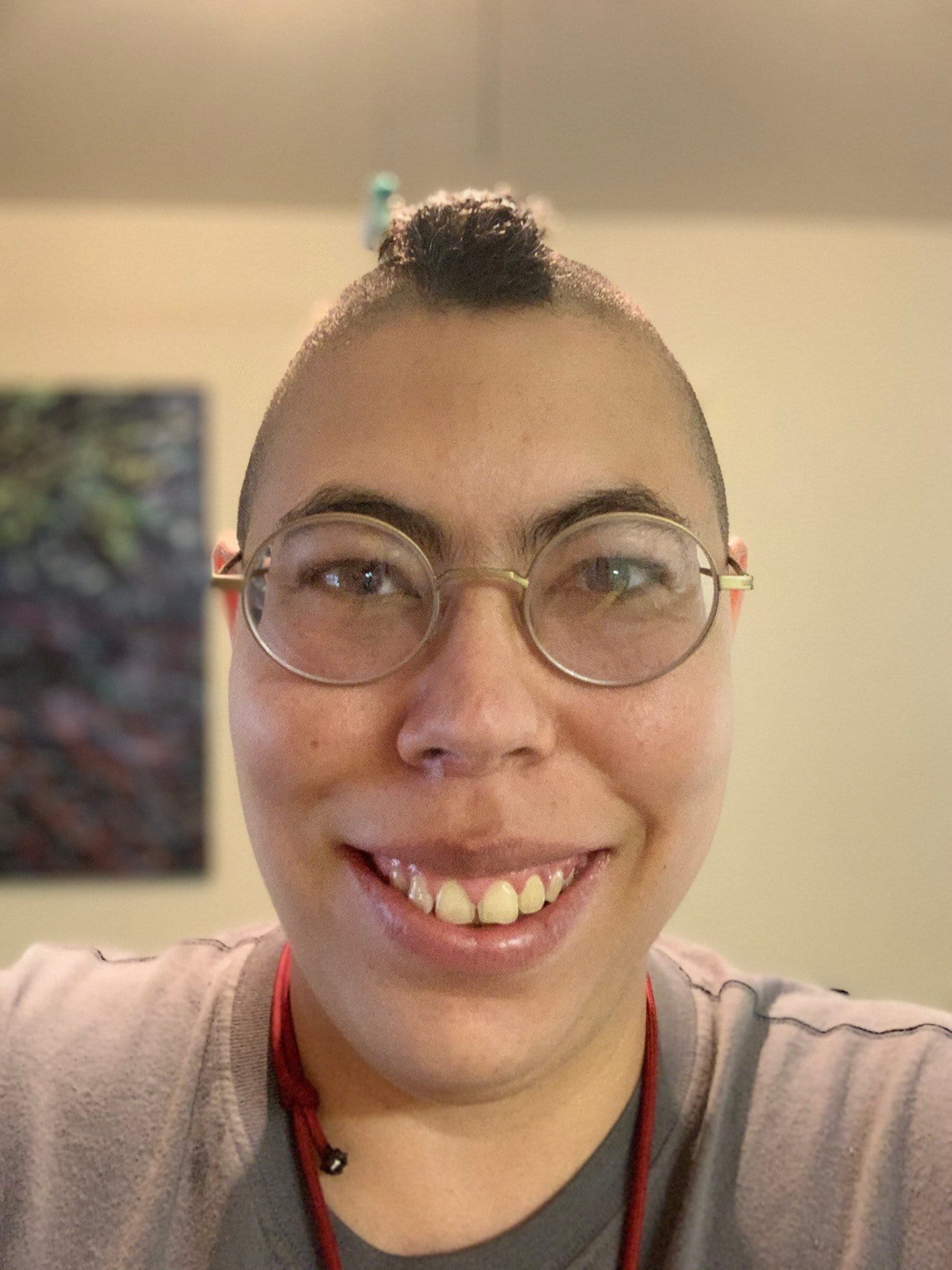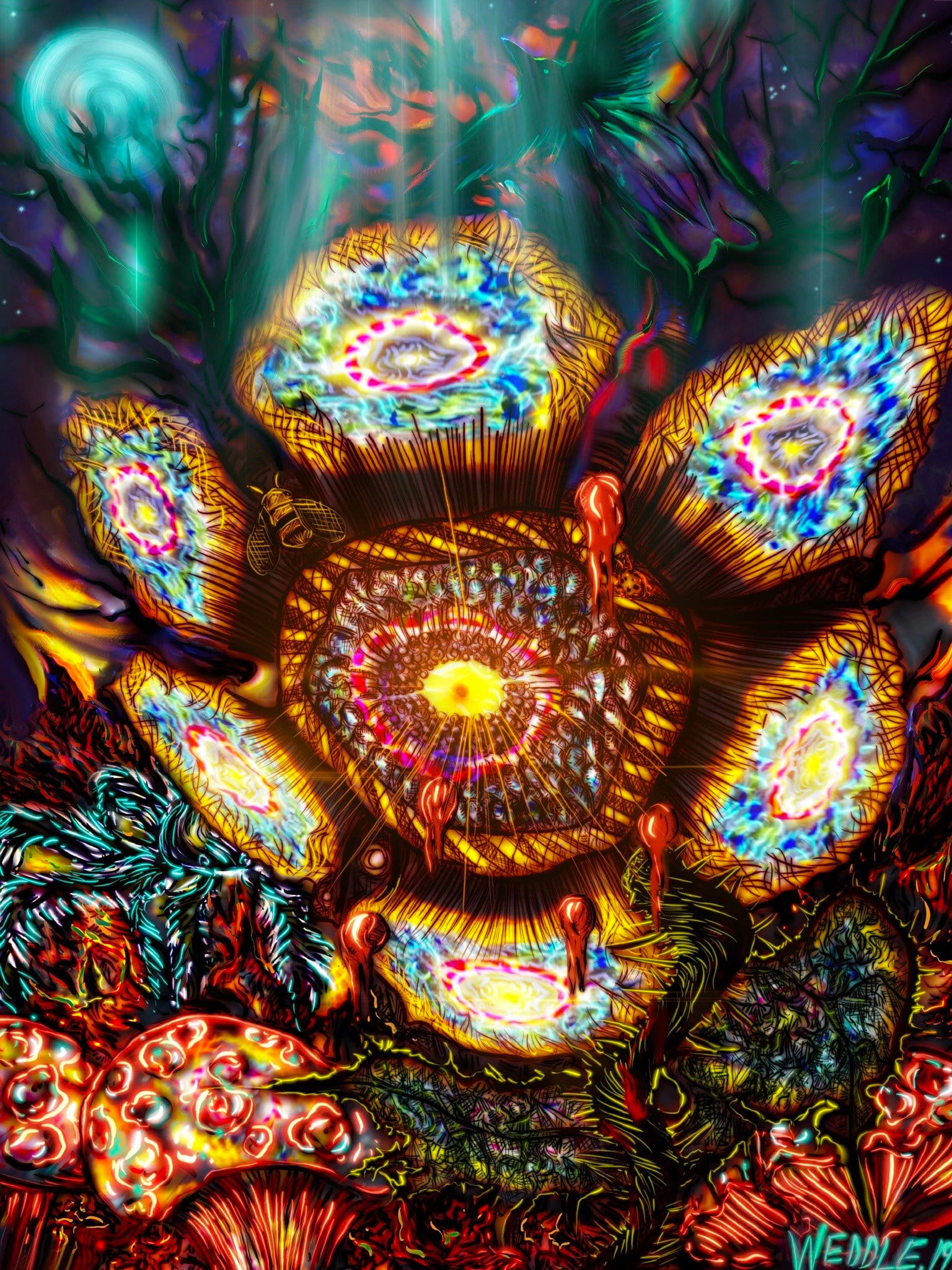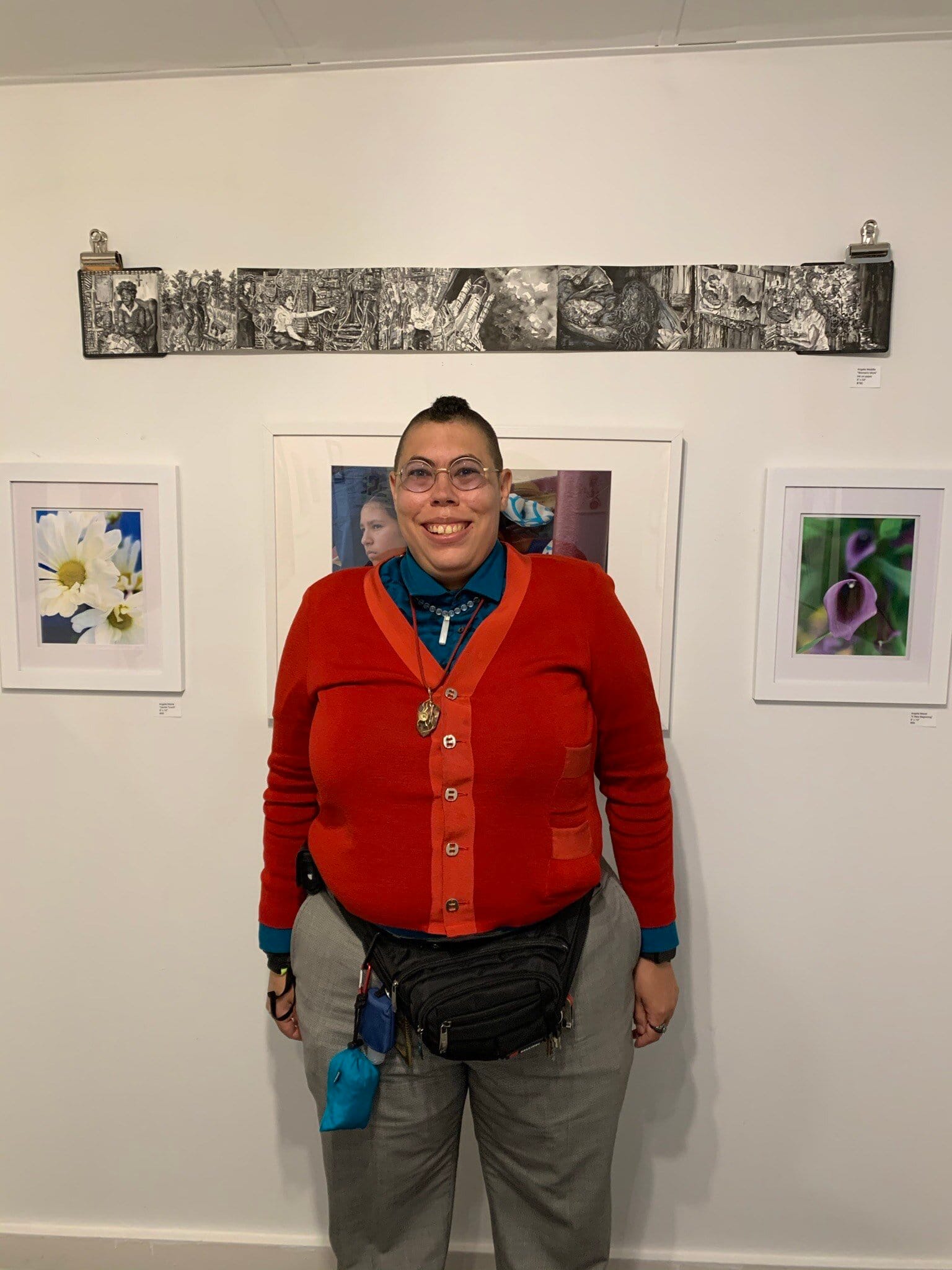“Thought in Action”: Art & Advocacy with Angela Weddle

Angela Weddle [image description: A BIPOC person smiles into the camera. She wears round, metal-framed glasses and a grey shirt. Her hair is styled as a narrow strip of curly brown hair, with the rest of the head shaved on both sides.
Jeneva Stone has the honor of interviewing Angela N. Weddle, a professional visual artist who is autistic with cerebral palsy and congenital right hemisphere brain damage. Weddle is a neurological anomaly and savant, who is not supposed to have any artistic ability but always has. Weddle has mentored and taught students of all ages about poetry and art.
Weddle is a contributing blogger, artist, animator, and board member of The Art of Autism. She has lectured about autism awareness and advocacy to local Texas organizations and corporations such as H.E.B. Weddle is known for her sketchbooks and digital art. She has been mentioned in the San Antonio Current, as well as interviewed on Spectrum News, and PopSugar. She has contributed animation/interviews to the University of Exeter’s ExDx Film project, and has been the featured artist in the literary journals Queerly and Salamander. Her cover art is featured on the CD of All Without Words by composer Justin Morell and multi-Grammy winning composer and musician John Daversa. Her poetry has been published in Barking Sycamores: Year One. For more on Weddle’s art, visit her website.
Tell me about yourself.
I’m a BIPOC, queer, autistic, and disabled visual artist, poet, and autistic advocate originally from New Orleans, LA. I currently reside in San Antonio, TX.
How did your interest in visual art develop? What do you consider to be your first artwork?
I had immediate interest from the moment I picked up a pencil. I started drawing obsessively for 4-5 hours a day on my own at 3 years old and considered myself an artist from age 4 onwards.
And I was always interested in representational art and realism; even at that age I would find myself frustrated when looking at the drawings other children did. I knew trees weren’t just round blobs with sticks for trunks. I knew leaves had individual shapes and the details and texture that made up the world. I was perplexed that other kids didn’t see it or so I thought. I strove to include that level of faithfulness from my earliest memories. No one told me how to draw or how or why to include those things.
My first artwork was a drawing of 4 ball gowns, it was the drawing that my mother really took notice of. She didn’t get upset that I interrupted her on the phone to show her. She realized something was there.
What are some connections between your artistic practice and your lived experience of disability?
Everything is connected to it. Growing up undiagnosed both as autistic and with cerebral palsy and congenital right hemisphere brain damage; I didn’t know that I wasn’t supposed to have the motor skills to be able to draw even badly. But I did know I had motor skills deficits, in general.
Being severely physically and verbally bullied in school, art was a way for me to tune some of that out. The more details included, the more time the drawing took; taking me out of that world. I was naturally interested in details but the above definitely informed that.
Also sensory issues. When I was in pre-k I remember they had us do a finger painting. I didn’t like the sensation of paint on my hands. I don’t like how glue and paint feel now, though I tolerate it better now. But I was far more upset that they didn’t really let us paint it. When it was my turn, they chose the colors and they placed my hands down on the paper. I could live with the uncomfortable sensation of the paint on my hands but was internally fuming that they thought I was incompetent to create a painting.
![“Woodlawn Lake, Early Autumn,” Sennelier Oil Sticks and Cold Wax Painting on Wood Panel, 10x10 inches, 2020. [image description: Impressionist techniques depict a pond with vegetation surrounding it, tall trees to the right, and clouds in the sky upper left. Brushstrokes are prominent.]](https://littlelobbyists.org/content/images/2025/05/1746226257811-woodlawn-lake-early-autumn.jpeg)
“Woodlawn Lake, Early Autumn,” Sennelier Oil Sticks and Cold Wax Painting on Wood Panel, 10x10 inches, 2020. [image description: Impressionist techniques depict a pond with vegetation surrounding it, tall trees to the right, and clouds in the sky upper left. Brushstrokes are prominent.]
This feeling returned in first grade. We were to draw a tree. I had been praised for drawing the trunk and thought I would get to paint the leaves. Only to have the teacher do the leaves. My mother and grandmother loved it but I remember being perpetually frustrated because the teacher didn’t do the leaves right. I perseverated on that tree for 20 years, eventually painting the version I originally envisioned maybe 8 years or so ago.
In addition having cerebral palsy, carpal tunnel in both wrists, spinal damage, fibromyalgia, other joint issues, and being unable to drive also inform my work. I tend to work in smaller sizes or digital because larger works are physically painful for me to do. I have special interests with certain formats like sketchbooks, accordion fold books, ink, digital, water media.
And of course since the U.S. disability system is archaic; their concepts of disability, mixed competencies, self employment; there are limitations to what I can do, earnings, transportation of works, many galleries aren’t accessible depending on whether and what kind of mobility equipment I am using. The types of art I make are all centered around a way to keep working for a brain and body that don’t function in traditional ways.
Even something like learning perspective took over 10 years for it to click; from a website that explained it in a non traditional way. I’m not a linear learner at all. Difficult things tend to be easy for me and easy things tend to be difficult. With NVLD-Non Verbal Learning Disability and profound math and spatial difficulties, something as simple as measuring a painting or doing a non standard sized work or sculpture can be very challenging or impossible even, but there is also an intuitive grasp of patterns as a pattern based thinker, fractals despite the inability to do most math, counting on my fingers, and despite being hyper verbal, visual art is my purest form of communication. Words are overwhelming, and visual art lets me communicate both in verbal and nonverbal periods.
![“Progress,” Pen and Ink Drawing, White gel pen, Artgraf ocher, graphite, and white washes, Micron colored pens, on Stonehenge Archival Kraft Paper, 11x14 inches, 2020. [image description: Construction equipment in yellow & brown in foreground, alongside fence. Telephone wires above, and storefront visible in background.]](https://littlelobbyists.org/content/images/2025/05/1746226270523-progress-aweddle.jpeg)
“Progress,” Pen and Ink Drawing, White gel pen, Artgraf ocher, graphite, and white washes, Micron colored pens, on Stonehenge Archival Kraft Paper, 11x14 inches, 2020. [image description: Construction equipment in yellow & brown in foreground, alongside fence. Telephone wires above, and storefront visible in background.]
In addition being alexithymic; alexithymia is a word that means no words for emotions. I have emotions but not the language for them always, especially the more subtle or in between emotions. Or I have delayed emotional processing. Realizing days or even months or years later how I felt and was affected by something. But my visual art in particular is my primary emotional language. It’s also the one place where I am an optimist.
I'm drawn to your use of line--even the straight lines feel animate! I'm thinking of "Alameda Theater at Night," "Urban Twilight," and "Ducks Bathing in San Pedro Creek" especially. Can you talk about this technique and why it's important to your work?
I’ve always loved drawing and ink drawing especially. I feel like it is thought in action. It is to me as honest as you can get in art. You can’t cover it up, you can only move forward. It can be quick, simple, economical or as detailed, precise, or expressive as one wishes. I feel like it’s an underrated medium, and requires patience. It’s like a form of meditation. And I think it’s versatile, whether using pen and the feedback from how it feels, to every breath potentially affecting the movement of a brush. I also love to create texture in a linear way. Though I may have sensory averse experiences with some mediums. I love texture. Line is a way of adapting to those sensory needs and creating that textural input. It’s also part of executive functioning differences. Seeing the whole from the part. Building the whole from these micro details as part of my nonlinear approach and thinking. Line is a living thing to me.
I'm also drawn to your use of light and color in pieces such as "Base Camp," "Pinball #1 Outer Limits," and "Night Ride, Hays Street Bridge." They remind me of Van Gogh--the inanimate becomes animate. Your website says you seek a "sensory, immersive experience." Can you talk about this a little bit more?

“Base Camp,” Digital Drawing, iPad Pro, Apple Pencil, Procreate, 2019. [image description: Psychedelic-style image of a flower-like structure (central round surrounded by six other round “petals”) appears as if, perhaps, below water among other aquatic fauna and flora. Red, yellow, blue and green hues are dominant against a black background.]
I never tried to emulate Van Gogh outside of one assignment in school; but I’ve always had this naturally post-impressionistic/expressionist style with color and most mediums.
A sensory, immersive experience is about literally showing my experience with light, sound, color, synesthesia. I had a teacher say once about my work that it was like reality wasn’t enough for me.
He was close; I’m very much a realist in my thinking. It’s that my reality is this heightened experience, which includes all the wonder and terror and everything else. I’ve had some autistic people say my work gives them sensory overload or it’s too intense. Other autistics appreciate it very much. I say to those who find it too intense it’s because you are also experiencing this. This is what I experience daily.
I read somewhere that when some neurotypicals take drugs that the kinds of experiences they have are quite autistic. People frequently ask me if I am using psychedelics when they see my art. I’m not. I don’t have to. I’m this way naturally. This is one reason why I fell in love with digital art when I first used it in my arts high school. The intensity of the light and color; drawing with light was closer to how I saw the world than even my favorite traditional mediums were. I envisioned something like the iPad then but didn’t know how to make one. As soon as it was available I got one and can bring those elements to life. I do still use some traditional media because some more physical haptic feedback is important from a perspective of interoception and other sensory needs sometimes.
How do you feel your disabled artistic practice differs from the practice of nondisabled artists?
I think the primary way it differs is the physical and financial considerations and limitations that I have to balance. And that of course, I want to support myself from my art like most artists; for me that means not simply dreaming big metaphorically but it’s all or nothing for me. Being disabled it either has to work or it doesn’t. I don’t get a choice to not go all in.
How can parents, families and allies best support the ambitions of disabled artists, and, especially, children and teens with such ambitions?

Angela Weddle poses in an art gallery with her work. [image description: The artist wears a red v-neck sweater over a navy shirt and grey pants. Her work appears as a long black and white strip above her head. She stands against a white wall with flower images on either side of her.]
I’m fortunate that my mother always supported me as an artist. With my mother and I both being BIPOC and neurodiverse and disabled, I was fortunate to have a parent that supported me from birth. And even with poverty and to this day struggles with income, that she invested in and exposed me to the arts in whatever ways she could.
I think anyone wanting to support the ambitions of disabled artists can do so by buying their work for one. I’m fortunate that my mother actually has purchased some of my works and respects what I do as work. By respecting us as competent artists and not a novelty. I’ve always disliked the term outsider art and the trend of profiting off of artists when basic needs aren’t being met, or being paraded around like we can’t and don’t have an understanding and deep investment in our ideas and work.
I think many academic institutions are gatekeepers now. So it’s no longer about the pure love of learning. Those institutions decide who gets to be the economic players and they keep out so many disabled and neurodiverse minds under the guise of a well rounded education. This guise is shallow however, when our work can be taught and exhibited in these institutions but our learning processes are not accommodated and the job market uses these institutional gatekeepers to determine worthiness; when these things occur, they effectively decide who gets to participate in society and at which level of those hierarchies. Praise isn’t enough to be functional.
So for me the biggest thing is advocacy because everything is connected. Advocating for a better disability system and social safety net. Advocating for public transportation as a human right. Something as simple as not having control over transportation and being able to go where you want whenever, being able to transport art or travel, for instance, really affects autonomy. Advocating for correct understandings of disability, including policy that is not only informed by but created by actually disabled people. Advocating for housing that is more than warehousing or more than policies that assume the most inhumane solutions, going beyond patronizing benevolence.
I greatly think most people over complicate things. I’m an artist because it’s what every fiber in me is wired to be, despite my brain supposedly being unable to. Because I’m good at it and because I enjoy it. I really detest artist statements and the intellectual rationalizations that the art world feels it must have for an instinctual human activity. I draw because I love it, I can, and I have to. I did so as a child and do so now. I, of course, was aware of the challenges of making a living with it. But when one is disabled one does not always fit into neurotypical jobs. There isn’t always something to fall back on. Especially with multiple disabilities. So as a child if I would have known that being disabled would have affected my art by making it a do or die proposition; that there wouldn’t just be the normal anxieties with being self employed but an urgency because this is it….if you want to advocate for your children think of the kind of life you want them to have as an adult. Because my life is always difficult. Having these systemic changes could give me an autonomy that would affect my art and everything else in ways I can’t imagine; to be able to breathe is what it would feel like.
If you had just one sentence to explain why art matters as a form of advocacy, what would you say?
Art speaks and reaches in ways that other formats can’t, and shows us the value of all of our humanity.
Jeneva Stone is the Little Lobbyists blog manager. She is also a writer. If you have an idea for our blog, or would like to be featured in it, email her.
